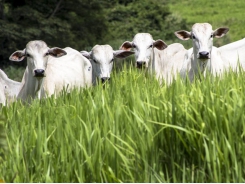Canada: Cattle feed tools shed light on ingredient nutrition, value

A set of new, online tools is aimed at making information about nutritional components in cattle feed and the economic value of feed or feed ingredients more accessible to livestock producers.
The Alberta Beef, Forage and Grazing Centre released the free feed evaluation tools at the end of June. The analysis tools include a way to apply or understand what the results of feed testing mean for the use of that feed, while the economic tool assesses feed value compared to other standard feed ingredients.
Development of the feed analysis and economic analysis tools followed challenging production periods in Alberta, said Karin Schmid, beef production specialist with Alberta Beef Producers and who was involved in creating the tools. However, they were not designed to address those specific conditions.
“It was more conceived of as a way to promote the best management practice of feed testing and ensuring that if there are issues with a certain feed source that it is rectified sooner rather than later in the feeding period,” she told FeedNavigator.
Additionally, both tools have relevance for producers across Canada and outside of the country, she said. However, the application could be more challenging for producers using different cattle weights or classes.
“The feed test analyzer is based on basic animal nutrition principles which don’t change with jurisdiction,” she said. “The economic analysis tool presents values in CAD [Canadian dollars], but because the dollar values don’t represent actual feed costs, it’s more important whether the final result is positive or negative and the relative difference between the values rather than the number itself – so that would be fairly universal.”
Prior to their release booth tools were piloted across Alberta and revised based on user feedback, said Schmid.
Understanding the results of feed testing
Development of the analysis tool aimed at helping producers better understand the results of feed testing stemmed from an interest in making feed testing more routine for livestock producers, said Schmid.
“We had also discovered that when we were at producer meetings or other events that some producers that were already feed testing were not doing anything with the results,” she said. “A common answer to the question of ‘What do you do with your feed test results?’ was ‘File it.’”
“That prompted the idea of designing something simple to use and easy to understand that would essentially ‘red flag’ a major issue with a single feed source in order to get producers one step further towards proper ration balancing, or at least get them to think about how to fix the problem,” she added.
The feed analysis tool can be used to check if a feed ingredient being used can meet the nutritional requirements of the animal being fed, the centre said. However, the tool is not intended to be used for ration balancing and it does not apply to cows in poor condition or facing extreme weather.
Instead, it was designed to highlight challenges with the use of a feed ingredient, so producers know when additional nutrition is needed, said Schmid. Adding, “For example, if you’re planning on feeding some hay through the winter for your pregnant cows, and you run the feed test results through the analyzer, if you see that TDN [total digestible nutrients] isn’t going to meet their requirements, you can plan on supplementing with some grain or other higher energy feed source.”
“We wanted this tool to give producers an idea of the quality of their feed sources,” she said. “If there were any potential problems, we hope it will drive them to use the other tools that already exist to solve those problems, like a nutritionist, ration balancing software, etc.”
Economic considerations
The tool established to check the economic value of feeds based on nutrient levels can be used to examine the quality of a feed or feed ingredient rather than making decisions based only on weight, said Schmid. “Most of the time, producers are buying feed by unit or by weight – by the bale or by the ton,” she added.
“By comparing the relative economic value on a nutrient basis (in this case protein and energy) for feed you are considering purchasing versus something you may already have on hand, you may see that you are getting better value by using the feedstuff on hand, or vice versa, in terms of protein and energy,” she said. “The other aspect to this that we hope producers realize when using the tool, is that by using a higher quality feed, you generally don’t need as much, which could represent further cost savings.”
The analysis compares feed price and nutritional elements like dry matter and crude protein with that of reference feeds, the centre said. It then can determine if feed ingredients would have a positive or negative influence on feed cost per ton.
Có thể bạn quan tâm
Phần mềm

Phối trộn thức ăn chăn nuôi

Pha dung dịch thủy canh

Định mức cho tôm ăn

Phối trộn phân bón NPK

Xác định tỷ lệ tôm sống

Chuyển đổi đơn vị phân bón

Xác định công suất sục khí

Chuyển đổi đơn vị tôm

Tính diện tích nhà kính

Tính thể tích ao hồ



 Yep dairy cows really love water beds
Yep dairy cows really love water beds  Seaweed slashes methane production in first live study…
Seaweed slashes methane production in first live study…